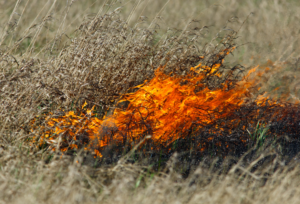Fires in Grasslands
Each ecosystem offers something different for fires. They adapted in different ways due to fires and the evolution required. Grassland fires tend to burn and spready more readily than shrubland and forest fires, which offers 
Quick Spread, Low Heat
The fires will spread through the steams and leaves of the herbaceous plants in the area. This helps them spread quickly, but it also means the fires don’t heat the underlying soil as much compared to shrublands and forests. This is even the case when the fire intensity is high.
The fires are a necessary part of recycling the nutrients, helping with the decomposition of the dying and dead material. In some ecosystems, fires are the only method of decomposition in grasslands, making them essential. The herbivorous creatures have moved out of the area, so they’re not longer grazing. There are a few reasons for this, including too many predators and moving out of the area due to too many fires.
However, due to the overuse of fire to maintain the ecosystems, there have been some issues. There’s a loss of carbon from the soil and an excess of oxidation. This can lead to the ecosystems not being able to respond properly for fires.
North American Grassland Fires
The Bromus tectorum is one of the types of grasses that have grown in North America. This type of grass is invasive and has contributed to the increase frequency of fires in the area. The grasses have also put pressure on the native species, leading to them not growing as well. This is a concern for grasslands around the United States and Canada.
Fires have worked with grazing in the past to help maintain the ecosystem. Oklahoma and Kansas are still benefitting from both together, making the invasive grasses as more of a concern for the west.
South African Savanna Fires
In South Africa, the savanna benefits from grassland fires. They help to promote new growth of nutritious forage around the areas, getting rid of the older and tougher grass. This helps to encourage more herbivores into the area, allowing them to graze on the grassland.
Fires are still necessary, but not on a large scale. The herbivores naturally keep the grass short. Only the types of plants that can adapt against heavy grazing will persist, minimizing the damage from fires naturally.
Some areas need to be encourage to burn to find a balance. This can move herbivores onto other areas, giving some other areas a chance to grow and adapt within an ecosystem. The balance is essential.
